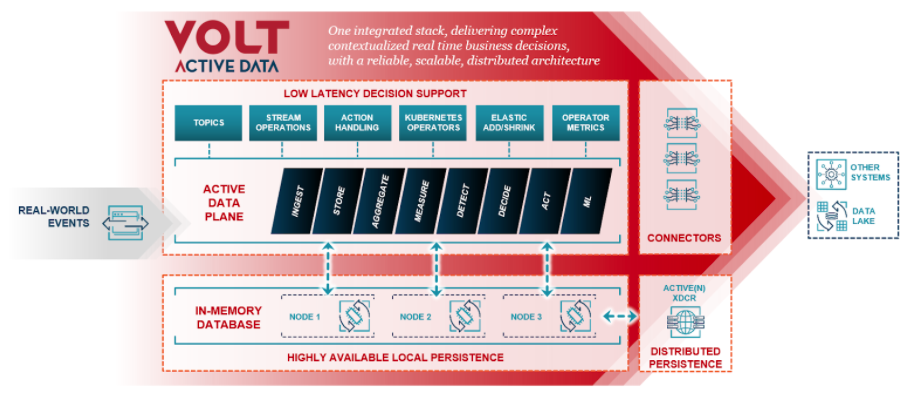Key Takeaways
- VoltDB has changed its name to Volt Active Data to better reflect the company's evolution and the changes in the real-time data market.
- The name change signifies a shift from being just a database to becoming a data platform that enables users to extract maximum value from their data by making it 'active'.
- Active data is dynamic and designed for processing high-velocity data 'in motion,' allowing businesses to respond to events and make real-time decisions.
- Volt Active Data's platform allows applications to respond to data with the full context necessary, enabling immediate detection and action on anomalous data.
- Volt Active Data offers a simplified stack that includes all the components needed to control real-world events and make real-time business decisions at 5G speed and scale.
As of today, VoltDB is no longer VoltDB, we are Volt Active Data—a name-modification that’s been a long-time coming and has involved numerous internal discussions, late-night realizations, early-morning coffees, and, potentially, a Slack debate or two.
The TL;DR version: we realized we needed to change our name to reflect both how the company has evolved since its founding in 2009 and also how the real-time data market itself has evolved (and is still evolving) with the arrival of powerful new disruptions such as 5G, IoT, and machine learning.
No—it’s not the announcement of a new product or a technological pivot, but it is the announcement of a major external change to better represent what we really do and what we’re really good at. It’s kind of like the new space telescope they just launched: a much clearer view and understanding of everything going on and why it’s happening, even though it’s always been there. In that sense, the change being only cosmetic doesn’t make it any less important than a new product announcement, merger, major hire, or anything else.
Must Read: Event-Driven Architecture
In this blog post, we’ll discuss why we’ve changed our name, what the new name means, and why our new name should be of interest to you or anyone else who needs to be able to act on data in real time to drive true business results and capitalize on the opportunities of 5G, IoT, machine learning, and whatever comes next.
First—a little context.
Table Of Contents
How the “DB” Part of VoltDB Was Born
VoltDB emerged in 2009 from research done by MIT’s Michael Stonebraker, who was obsessed with figuring out why OLTP systems were slowing down and failing to scale with the multi-CPU architectures that were rapidly becoming dominant at the time.
Stonebraker discovered that OLTP system slowness was caused by the use of on-disk data and lack of CPU coordination and designed VoltDB to address both of these issues via sharding and in-memory data.
His breakthroughs made VoltDB essentially the fastest database in the West—and, er East. And as VoltDB evolved with the industry, it reached a point where it had evolved into much more than a database—it had become a data platform, and not just any data platform but one that could accomplish things other data platforms couldn’t.
Must Read: What is URLLC?
Why ‘Active Data’?
In our many name-change discussions, the main thing we focused on was: What’s the core differentiator of Volt (the short version of our name from now on, by the way)? There are other data platforms out there, of course. What makes Volt different? We couldn’t just say we were faster (which we are), because we were more than just faster.
So then we started thinking about how Volt handles data. What do we do with all of this data flowing into all these systems and devices that other data platforms struggle to do and how does that help our customers so much with their business outcomes?
It was then we realized that, when you put all the puzzle pieces together and think about the Volt platform’s capabilities as a whole and what it’s delivering, essentially what we allow you or any other company to do is extract the most value possible from your data by making it (your data) active.
ACTIVE (Adjective) = Engaged in action; Being in a state of progress or motion; Having the power of quick motion.
Active data is dynamic as opposed to static. It’s designed for a world where high-velocity data is processed ‘in motion’—that is, the world of 5G-enabled markets. Having an active data platform means you act on data while it still has maximum value and impact for your business. However, you can only do that if you can bring together every data processing component you need to control real-world events and make real-time business decisions at 5G speed and scale.
That’s the power of active data and Volt’s active data platform—rather than simply reacting to data, you can start responding to it.
Other data platforms, such those powered by NoSQL technology, don’t respond to data—they react to it—because they lack the power to take decisions by themselves. It’s kind of a way of saying they are stupid, but… a nicer way.
Volt, on the other hand, allows your applications to respond to data by empowering them not with just speed but with the full context necessary to respond in the most appropriate manner.
This is especially important for anomalous data—Volt immediately detects and acts on that data, deciding whether it’s something to take seriously or not, and if it is, ensuring it’s kept for current and future use so that:
- That upsell offer is made at just the right moment for just the right customer.
- That credit card fraud is blocked before it even happens.
- That incorrect phone data charge never goes through to the customer because it’s flagged in real time.
- That industrial smart meter is really smart because it knows exactly when those lights need to go on and off to save the city the most money possible and it relays this information clearly.
All of the above are just a few of the many examples of the power and importance of real-time contextual decision making via an active data platform.
That’s why we call it ‘Active Data’—because it’s not just passively reacting to events, it’s responding to them by making their related data go to work for your bottom line and core business KPIs.
Goodbye “DB”, Hello Active Data
The Volt Active Data Platform is battle-tested and is an integral part of the daily lives of more than 700 million people across the globe. It can replicate data across three (or more!) active data centers to ensure uptime, it’s cloud native, and it’s virtually interoperable with Kafka.

Volt Active Data still uses the VoltDB database but only to store relevant data for later use.
In Volt Active Data, the work happens in the Active Data Plane:
The ingest function allows us to read messages off the network, either using our wireline API and a C++/Java client or off Kafka.
We only store data if we need to. Unlike a database, which is “Always Store And Sometimes Process”, Volt is “Always Process And Sometimes Store”.
Many use cases need to understand patterns over thousands of events and also have a need to aggregate data. Volt Active Data has built-in features that allow us to provide perfectly accurate running totals without having to scan or process any data at query time.
Many use cases will require us to take incoming events and measure them in some non-trivial way to provide the basis for a decision.
Other use cases will need us to detect anomalies. The Volt Active Data plane allows us to spot when something hasn’t happened as expected, as well as being driven by incoming events.’
The core of the Volt Active Data plane is the ability to decide what to do next. This often involves looking at stored state to determine what was supposed to have happened, as well as examining input events.
Sometimes the decision process will involve machine learning. Volt Active Data will work with any deterministic ML decision engine as long as it’s in Java and can be instantiated inside a class.
Once a decision has been made we need to act. This could involve updating stored data and/or sending multiple messages. When you activate your data, you can extract the most value possible from it and transform your business with applications that process more data, faster and more securely, while dramatically cutting costs.
And Now It’s Your Turn to ‘Activate Your Data’
Unlike traditional data platforms built around multiple processing, analytics, and storage layers, our product delivers, in one simplified stack, every component you need to control real-world events and make real-time business decisions at 5G speed and scale.
And we can back up what we say because we’re an integral part of mission-critical systems all over the world.
Not everyone needs us, both those that do need us really need us.
Here’s a quick litmus test:
- If you’re in the business of using high volumes of event data to make fast, commercially meaningful business decisions, you should talk to us.
- If you require high availability, you should talk to us.
- If your applications process massive volumes of data from 5G or IoT, you should talk to us.
- If your edge data seems to be going to waste, you should talk to us.
- If you require a simpler architectural footprint that gets your data from A to B with way less hardware and headaches, you should talk to us.
- If ‘real-time’ for you means zero lag, but your applications haven’t yet achieved zero lag, you should talk to us.
We’d also love to hear what you think about our new name and we’d love to answer any questions you have about it or what it means for you.
Please leave a comment below or contact us at info@voltactivedata.com today.



